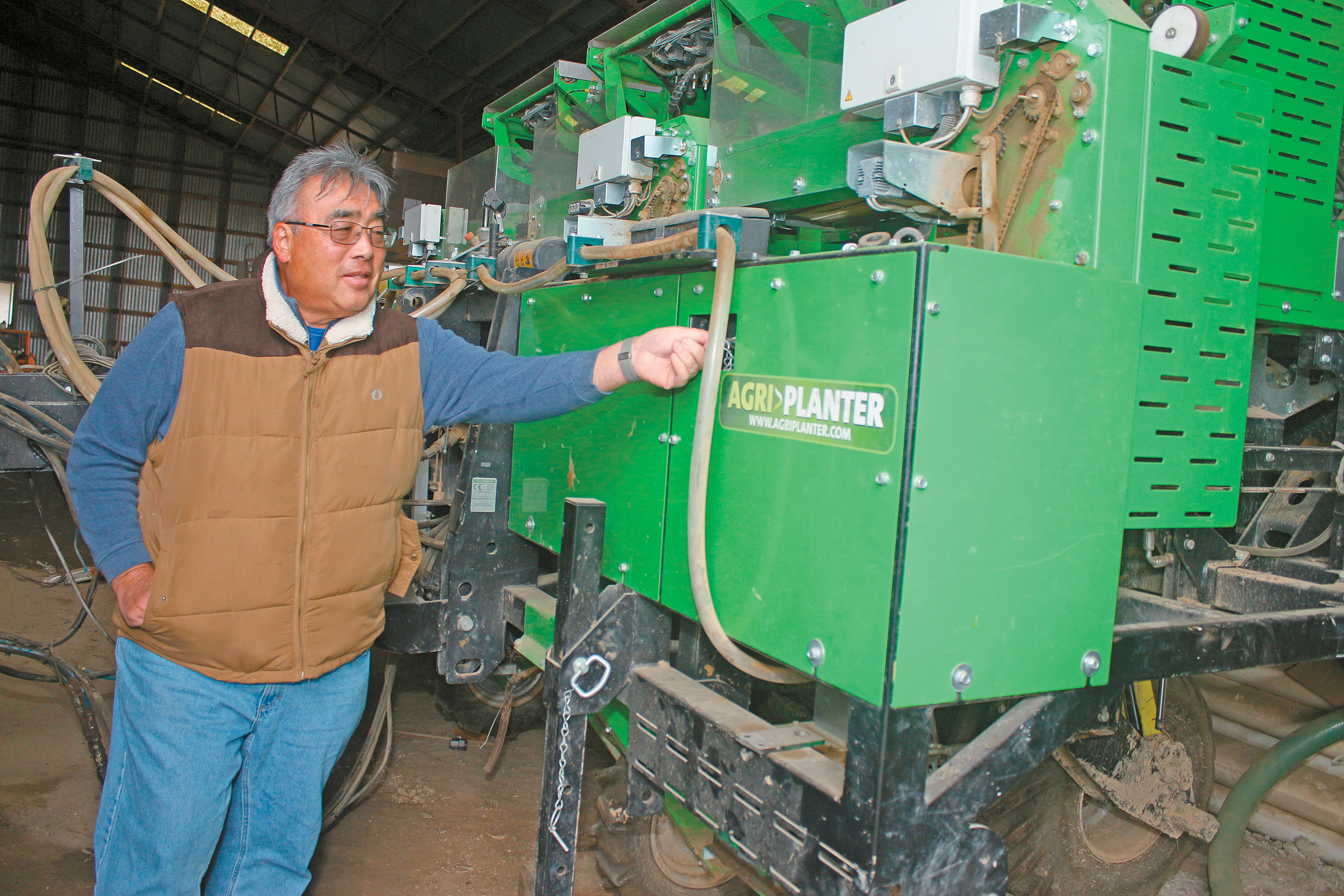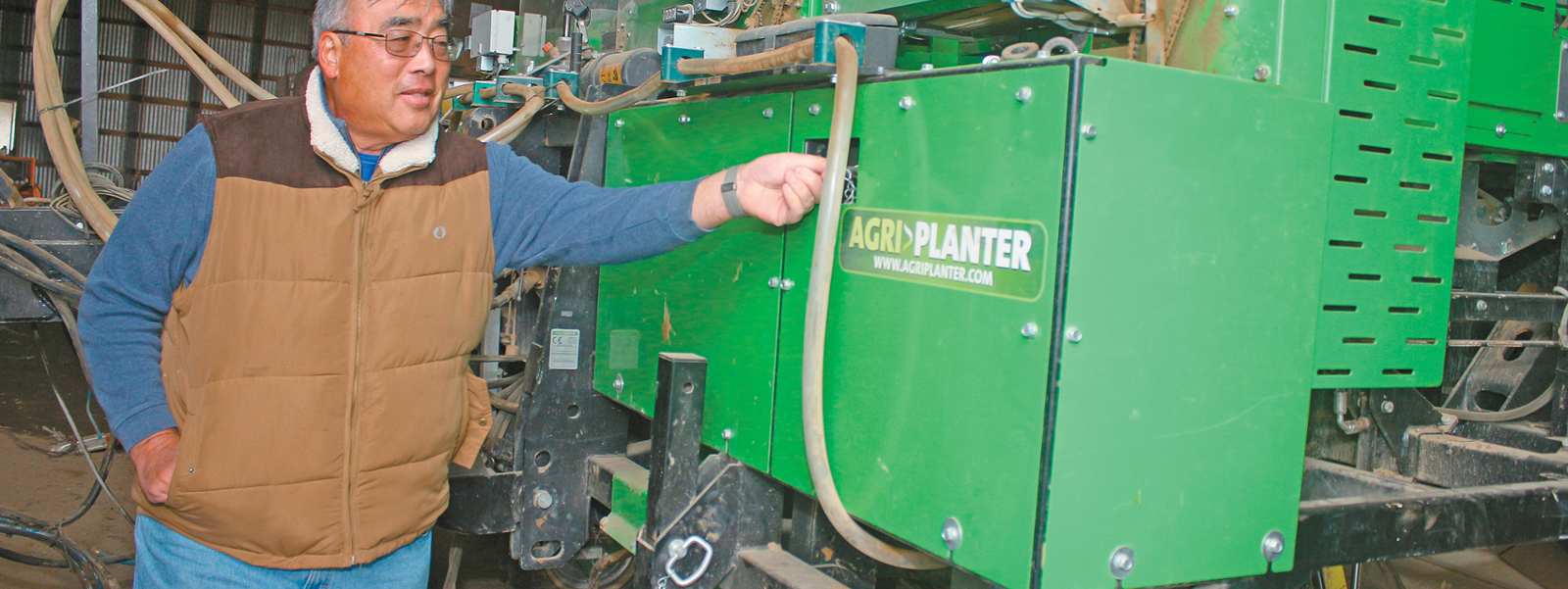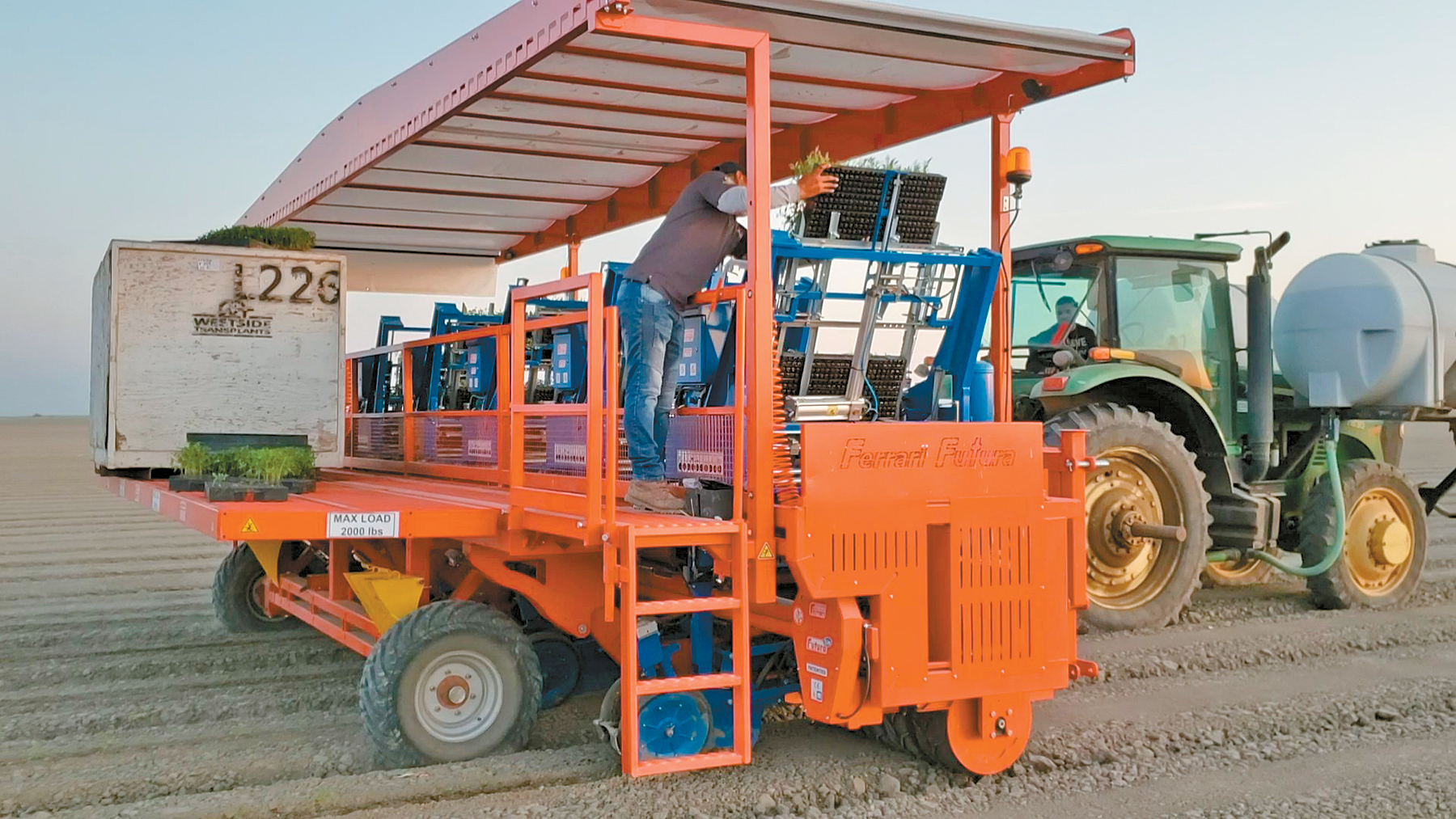Farmers look to automate transplanting

Yolo County vegetable farmer Ray Yeung shows one of the few fully automated transplanters on the market, the Agriplanter, made by the Belgium company Agriplant. The machine, disassembled for winter maintenance in his shop, can plant seedlings using as few as two people in the field.
Photo/Ching Lee


Photo/Courtesy of Brad Strock
By Ching Lee
With farm labor costs increasing and worker availability shrinking, growers continue to look to automation and robotics to do jobs traditionally done by people.
In vegetable farming, equipment commonly used to plant delicate seedlings still requires a crew. Manufacturers of fully automated transplanters want to change that, and early adopters such as Yolo County farmer Ray Yeung say the machines are ready for prime time, though they may be cost prohibitive for some farms.
Yeung was the first in California to acquire the Agriplanter by the Belgium company Agriplant after seeing a Facebook post about it three years ago. The machine has been around for 20 years, according to Eric Puehler, a U.S. Agriplanter distributor in Ohio. But it did not debut on American soil until 2019, on a New Jersey farm. There are now 31 Agriplanters in the U.S., with 13 in California, he said.
Other automated transplanting systems being used on California farms include Ferrari Growtech’s Futura from Italy (no relation to the sports car) and PlantTape, owned by Salinas-based vegetable producer Tanimura & Antle.
Yeung, who specializes in tomatoes and also operates a custom transplanting business, said his move to automate planting was driven by need. He said hiring enough employees willing to work on a planter has become increasingly difficult, especially during the early days of the pandemic due to social-distancing requirements.
“We couldn’t find people,” he said. “I said, ‘We’ve got to think of something.’ That’s when I saw that Facebook post.”
Yeung said older transplanters such as the finger-style planters and the semi-automatic carousel planters still work well, but they require more people to run. Workers must manually handle the individual seedlings and drop them into cups, which in turn drop the plants into furrows made by the machine. A crew usually follows the planter to fill in any skips. Such planters have improved over the years, he said, but the basic concept has been the same for decades.
With fully automated transplanters, typically one person drives a tractor pulling the transplanter while another works in the back feeding the machine trays of seedlings. Yeung said he can plant 30 acres a day with the Agriplanter, whereas with the finger planter, “we’ll be lucky to get 8 or 9 acres.” Having fewer people in the field also creates less hazard, he added.
“It just makes it go faster and easier with this new technology,” he said, predicting more farmers will be forced to go fully automated in the next 10 years due to the dwindling workforce.
Fully automated transplanters on the market tend to run several hundred thousand dollars, which may not be feasible for small and medium-sized farms.
The price of the Ferrari Futura, for example, ranges from $80,000 to more than $500,000, depending on the number of rows the grower wants to plant in a single pass, number of plant lines on the bed and if it’s a self-propelled or tractor-pulled version, said Brad Strock, a dealer in Firebaugh who also runs a transplanting business. He said he expects the return on investment to be about two to five years, depending on the user’s farming practices.
Puehler said the Agriplanter typically pays for itself in one to two years for California farmers and four to five years for growers in the Midwest, depending on the size of the operation.
Yeung said the labor cost is about $250 to $270 an acre to run a finger planter vs. $50 to $60 an acre for the Agriplanter.
Some farmers remain unconvinced the new machines perform as well as more traditional planters, with concerns that savings in labor will not offset yield losses, said Patricia Lazicki, a University of California vegetable crops advisor. She started a study last year comparing the Agriplanter, a finger planter and carousel planter.
With funding from the California Tomato Research Institute, she plans this year to compare the finger planter, the Ferrari F-Max carousel planter, the Agriplanter, the Ferrari Futura and the PlantTape, so called because the transplants are sown between two strips of biodegradable tape.
Questions remain about the various automated planters’ effects on yield, Lazicki said. What’s the survival rate of the plants? Are there more skips in planting going more than 3 miles an hour? In manual systems, skips are filled in by people walking behind the planter. During last year’s trial, Lazicki said long skips tended to be due to misalignment or cracks in the tray.
“The most important piece of infrastructure to the planter’s success is good-quality trays,” Puehler, the Agriplanter dealer, said.
Yeung and Tony Turkovich, a Yolo County farmer who started using the Agriplanter for processing tomatoes last year, agree that problems related to skips have more to do with the condition of the transplants. Plant uniformity and size—ideally 6 to 8 inches tall—remain key. If the plants are too small, they can get buried. If they’re too big, the leaves start to tangle with each other, which can cause the machine to grab multiple plants. Overgrown plants can also plug up other components of the machine.
“The biggest area of challenge is the greenhouse and the plants,” Strock said. Even though nurseries try to time their production with farmers’ planting schedule, he said, “you’re dealing with God and the weather.” The wet spring last year caused delays in planting, with transplants becoming overgrown in the greenhouse.
Hoy Buell, who operates Greenheart Farms, a vegetable transplant nursery in San Luis Obispo County, said growers choose transplanting over direct seeding because they can get more uniform plants. His company also developed an automated transplanter that he said can plant 20 transplants per second. The machine, called Zenon, has been in development for 10 years and won’t be on the market until the controls are redone, he said.
Buell said he thinks his planter can be produced a little cheaper than other market options, “but it will still be quite expensive.” Despite grower interest in automated transplanters, he noted cost of the technology has not come down enough to make it affordable for smaller farms.
“They’re not being readily adopted because they’re very expensive,” he said. “You only have three months production period, and then those machines are going to sit for nine months.”
As for problems of skips and impacts on yield, Buell said they tend to be more critical with vegetables such as cabbage or lettuce in which the plant itself is the product. With tomatoes, the plants can compensate by filling in the empty spaces of the plants that didn’t get planted.
Turkovich said despite planting delays last year and some transplants becoming too big, causing skips in the field, “the crop turned out very good.” With improvements in automation, worker wage increases, lack of available employees and state overtime rules for agricultural workers, he said more farmers will likely be forced to adopt this type of technology.
“It’s a huge capital cost up front, but we did save money on the transplanting,” he said. “It’s just a matter of whether over multiple years we’ll save money to offset the capital costs, and right now, we still expect that to happen.”
(Ching Lee is an assistant editor of Ag Alert. She may be contacted at clee@cfbf.com.)




